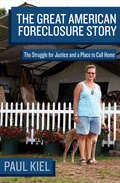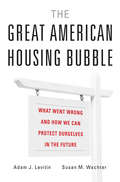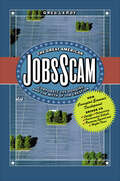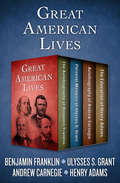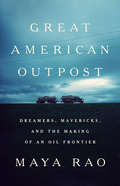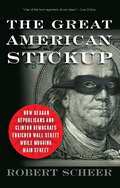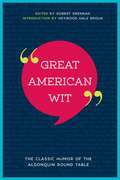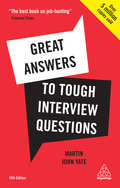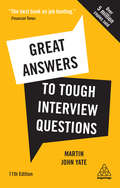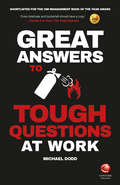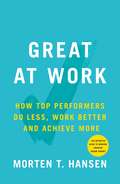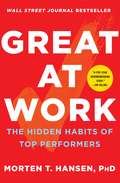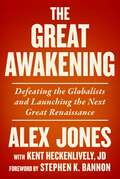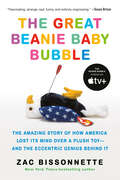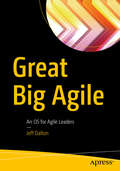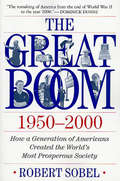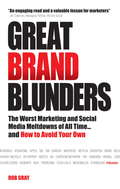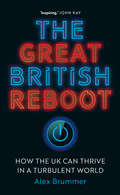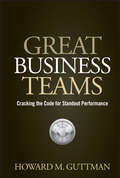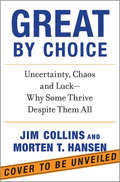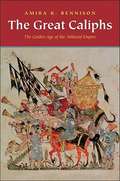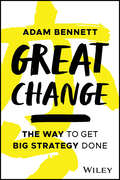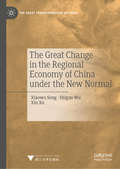- Table View
- List View
The Great American Foreclosure Story
by Paul Kiel Olga Pierce Cora CurrierProPublica's mesmerizing and groundbreaking look at the national housing crisis, told through the lens of one woman whose story came to exemplify itSheila Ramos's story mirrors the lives of millions of Americans who have lost their homes since the beginning of the housing crisis in 2007. The Great American Foreclosure Story details with clarity and empathy the road that led Ramos and so many like her toward financial ruin. Once the owner of a small business and a home, Ramos fell on hard times. Predatory lending and denied loan-modification applications eventually sent her and her three grandchildren packing, leaving behind their house in Florida and winding up in a tent outside of Ramos's faraway hometown. Alongside Ramos's story are additional investigations by ProPublica reporter Paul Kiel and his colleagues Olga Pierce and Cora Currier documenting the systematic failures at banks, mortgage servicers, and government watchdogs that have exacerbated the country's most severe foreclosure crisis since the Great Depression. Drawing from whistleblower testimonies, extensive homeowner databases, and a trove of underlying data, The Great American Foreclosure Story is a comprehensive and unrivaled look at the housing crisis, and its continuing human toll.
The Great American Housing Bubble: What Went Wrong and How We Can Protect Ourselves in the Future
by Adam J. Levitin Susan M. WachterThe definitive account of the housing bubble that caused the Great Recession—and earned Wall Street fantastic profits. The American housing bubble of the 2000s caused the worst global financial crisis since the Great Depression. In this definitive account, Adam Levitin and Susan Wachter pinpoint its source: the shift in mortgage financing from securitization by Fannie Mae and Freddie Mac to “private-label securitization” by Wall Street banks. This change set off a race to the bottom in mortgage underwriting standards, as banks competed in laxity to gain market share. The Great American Housing Bubble tells the story of the transformation of mortgage lending from a dysfunctional, local affair, featuring short-term, interest-only “bullet” loans, to a robust, national market based around the thirty-year fixed-rate mortgage, a uniquely American innovation that served as the foundation for the middle class. Levitin and Wachter show how Fannie and Freddie’s market power kept risk in check until 2003, when mortgage financing shifted sharply to private-label securitization, as lenders looked for a way to sustain lending volume following an unprecedented refinancing wave. Private-label securitization brought a return of bullet loans, which had lower initial payments—enabling borrowers to borrow more—but much greater back-loaded risks. These loans produced a vast oversupply of underpriced mortgage finance that drove up home prices unsustainably. When the bubble burst, it set off a destructive downward spiral of home prices and foreclosures. Levitin and Wachter propose a rebuild of the housing finance system that ensures the widespread availability of the thirty-year fixed-rate mortgage, while preventing underwriting competition and shifting risk away from the public to private investors.
The Great American Jobs Scam: Corporate Tax Dodging and the Myth of Job Creation
by Greg LeRoyFor the past 20 years, corporations have been receiving huge tax breaks and subsidies in the name of "jobs, jobs, jobs." But, as Greg LeRoy demonstrates in this important new book, it's become a costly scam. Playing states and communities off against each other in a bidding war for jobs, corporations reduce their taxes to next-to-nothing and win subsidy packages that routinely exceed $100,000 per job. But the subsidies come with few strings attached. So companies feel free to provide fewer jobs, or none at all, or even outsource and lay people off. They are also free to pay poverty wages without health care or other benefits. All too often, communities lose twice. They lose jobs--or gain jobs so low-paying they do nothing to help the community--and lose revenue due to the huge corporate tax breaks. That means fewer resources for maintaining schools, public services, and infrastructure. In the end, the local governments that were hoping for economic revitalization are actually worse off. They're forced to raise taxes on struggling small businesses and working families, or reduce services, or both. Greg LeRoy uses up-to-the-minute examples, naming names--including Wal-Mart, Raytheon, Fidelity, Bank of America, Dell, and Boeing--to reveal how the process works. He shows how carefully corporations orchestrate the bidding wars between states and communities. He exposes shadowy "site location consultants" who play both sides against the middle, and he dissects government and corporate mumbo-jumbo with plain talk. The book concludes by offering common-sense reforms that will give taxpayers powerful new tools to deter future abuses and redirect taxpayer investments in ways that will really pay off.
Great American Lives: The Autobiography of Benjamin Franklin, Personal Memoirs of Ulysses S. Grant, Autobiography of Andrew Carnegie, and The Education of Henry Adams
by Benjamin Franklin Henry Adams Andrew Carnegie Ulysses S GrantBrilliant, captivating, and unforgettable memoirs from four of the greatest minds in American history. Penned between 1771 and 1790 and published after his death, TheAutobiography of Benjamin Franklin is one of the most acclaimed and widely read personal histories ever written. From his youth as a printer's assistant working for his brother's Boston newspaper through his own publishing, writing, and military careers, his scientific experiments and worldwide travels, his grand triumphs and heartbreaking tragedies, Franklin tells his story with aplomb, bringing to life the flesh-and-blood man behind the American icon. Completed just days before his death, Ulysses S. Grant's Personal Memoirs is a clear and compelling account of his military career, focusing on two great conflicts: the Mexican-American War and the Civil War. Lauded for its crisp and direct prose, Grant's autobiography offers frank insight into everything from the merits of the war with Mexico to the strategies and tactics employed by Union forces against the Confederacy to the poignancy of Grant's meeting with General Lee at Appomattox Court House. Documenting a world of tariffs, insider deals, and Wall Street sharks as well as his stunning rise from bobbin boy to steel baron, The Autobiography of Andrew Carnegie opens a window into the great industrialist's decision-making process. His insights on education, business, and the necessity of giving back for the common good set an inspirational example for aspiring executives and provide a fitting testament to the power of the American dream. The Education of Henry Adams is the Pulitzer Prize-winning memoir of a brilliant man reckoning with an era of profound change. The great-grandson of President John Adams and the grandson of President John Quincy Adams, Henry Adams possessed one of the most remarkable minds of his generation. Yet he believed himself fundamentally unsuited to the era in which he lived--the tumultuous period between the Civil War and World War I. Written in third person, this uniquely unclassifiable autobiography is the Modern Library's number-one nonfiction book of the twentieth century. This ebook has been professionally proofread to ensure accuracy and readability on all devices.
Great American Outpost: Dreamers, Mavericks, and the Making of an Oil Frontier
by Maya RaoA surreal, lyrical work of narrative nonfiction that portrays how the largest domestic oil discovery in half a century transformed a forgotten corner of the American West into a crucible of breakneck capitalism.As North Dakota became the nation's second-largest oil producer, Maya Rao set out in steel-toe boots to join a wave of drifters, dreamers, entrepreneurs, and criminals. With an eye for the dark, absurd, and humorous, Rao fearlessly immersed herself in their world to chronicle this modern-day gold rush, from its heady beginnings to OPEC's price war against the US oil industry. She rode shotgun with a surfer-turned-truck driver braving toxic fumes and dangerous roads, dined with businessmen disgraced during the financial crisis, and reported on everyone in between--including an ex-con YouTube celebrity, a trophy wife mired in scandal, and a hard-drinking British Ponzi schemer--in a social scene so rife with intrigue that one investor called the oilfield Peyton Place on steroids.As the boom receded, a culture of greed and recklessness left troubling consequences for investors and longtime residents. Empty trailers and idle oil equipment littered the fields like abandoned farmsteads, leaving the pioneers who built this unlikely civilization to reckon with their legacy. Part Barbara Ehrenreich, part Upton Sinclair, Great American Outpost is a sobering exploration of twenty-first-century America that reads like a frontier novel.
The Great American Stickup: How Reagan Republicans and Clinton Democrats Enriched Wall Street While Mugging Main Street
by Robert ScheerInThe Great American Stickup, celebrated journalist Robert Scheer uncovers the hidden story behind one of the greatest financial crimes of our time: the Wall Street financial crash of 2008 and the consequent global recession. Instead of going where other journalists have gone in search of this story-the board rooms and trading floors of the big Wall Street firms-Scheer goes back to Washington, D. C. , a veritable crime scene, beginning in the 1980s, where the captains of the finance industry, their lobbyists and allies among leading politicians destroyed an American regulatory system that had been functioning effectively since the era of the New Deal. This is a story largely forgotten or overlooked by the mainstream media, who wasted more than two decades with their boosterish coverage of Wall Street. Scheer argues that the roots of the disaster go back to the free-market propaganda of the Reagan years and, most damagingly, to the bipartisan deregulation of the banking industry undertaken with the full support of “progressive” Bill Clinton. In fact, if this debacle has a name, Scheer suggests, it is the “Clinton Bubble,” that era when the administration let its friends on Wall Street write legislation that razed decades of robust financial regulation. It was Wall Street and Democratic Party darling Robert Rubin along with his clique of economist super-friends-Alan Greenspan, Lawrence Summers, and a few others-who inflated a giant real estate bubble by purposely not regulating the derivatives market, resulting in the pain and hardship millions are experiencing now. The Great American Stickupis both a brilliant telling of the story of the Clinton financial clique and the havoc it wrought-informed by whistleblowers such as Brooksley Born, who goes on the record for Scheer-and an unsparing anatomy of the American business and political class. It is also a cautionary tale: those who form the nucleus of the Clinton clique are now advising the Obama administration.
Great American Wit: The Classic Humor of the Algonquin Round Table
by Robert E. Drennan Heywood Hale BrounThe perfect gift for the snarky literature fan in your life! “Stop looking at the world through rose-colored bifocals.” “His mind is so open, the wind whistles through it.” “You can’t teach an old dogma new tricks.” Ever wonder where these sayings came from? For decades, the dining room of New York’s legendary Algonquin Hotel was a hub of letters and humor. Cocktails swirled as writers, humorists, actors, and critics poked fun at culture, the arts, and one another. In this lively tribute, today’s readers will come to understand why Robert Benchley, George S. Kaufman, and Dorothy Parker represent the epitome of quips and comebacks—wit that still packs a punch decades later. Each chapter contains:A short biographical sketch A photo of the great American wit Handpicked collection of quotes and anecdotes Packaged in a contemporary cover, this is the perfect gift or coffee table book. Discover the sarcasm, double entendres, insults, and jabs that earned these sharp minds the collective title of “the Vicious Circle.”
Great Answers to Tough Interview Questions
by Martin John YateGreat Answers to Tough Interview Questions is the essential companion for all job-seekers. One of the best-selling job-hunting books of all time, having sold over 5 million copies, it takes you through the whole process; from composing your CV and preparing for interviews to interview techniques, answering tough questions and even negotiating your new salary. Crammed full of the difficult questions that interviewers might throw at you, Martin John Yate gives you expert tips and suggested answers to tackle the tricky ones including:Why should I give you the job? What is your biggest weakness? What are your salary expectations? How long would you stay with the company? What is your greatest strength? Why do you want to work here? Great Answers to Tough Interview Questions will help anyone at any stage of their career. It is your indispensable guide to blowing away the competition and landing your dream job.
Great Answers to Tough Interview Questions: Your Comprehensive Job Search Guide with over 200 Practice Interview Questions
by Martin John YateGreat Answers to Tough Interview Questions is the essential companion for all jobseekers. With over 5 million copies sold, this bestseller takes you through the whole process: from composing your CV and preparing for interviews, to interview techniques, answering tough questions and even negotiating your new salary. Crammed full of the difficult questions that interviewers might throw at you, Martin John Yate gives you expert tips and suggested answers to tackle the tricky ones including:Why should I give you the job? What is your biggest weakness? What are your salary expectations? How long would you stay with the company? What is your greatest strength? Why do you want to work here? Now in its 11th edition, Great Answers to Tough Interview Questions is your indispensable guide to blowing away the competition and landing your dream job.
Great Answers to Tough Questions at Work
by Michael DoddThe essential guide to turning tough questions into positive opportunities Difficult questions can be thrown at you from your first job interview through to challenges you get when you've made it to the top. If you find yourself on the firing line on a regular or occasional basis this is the perfect go-to guide to help you turn tough questions into positive opportunities. Great Answers to Tough Questions at Work promotes a confident 'win-win-win' mindset for questioner, answerer and wider audiences beyond. Author Michael Dodd provides golden formulae and proven strategies for constructing inspirational answers--however challenging, vicious, tricky or stupid the question. He outlines simple but successful techniques for dealing with the kind of nightmare questions which all ambitious people in the workplace have to face along their journey, whatever stage of their career. Contains critical communication skills for executives, managers, leaders and those aspiring to fill these roles Covers a wide range of work place scenarios such as job interviews, performance reviews, negotiations, customer relations, parliamentary inquiries and cross-examination Discusses how to see the issues underlying tough questions that you face in a different, more positive, solution-oriented way Includes case study examinations of key moments where people in the public spotlight have done something particularly well or particularly badly while answering questions and draws out the lessons for readers.
Great at Work: How Top Performers Do Less, Work Better, and Achieve More
by Morten HansenFrom the New York Times bestselling author of Great by Choice comes an authoritative, practical guide to individual performance - based on analysis from an exhaustive, groundbreaking study.Why do some people perform better at work than others? This deceptively simple question continues to confound professionals in all sectors of the workforce. Now, after a unique, five-year study of more than 5,000 managers and employees, Morten Hansen reveals the answers in his 'Seven Work Smarter Practices' that can be applied by anyone looking to maximise their time and performance. Each of Hansen’s seven practices is highlighted by inspiring stories from individuals in his comprehensive study. You’ll meet a high school principal who engineered a dramatic turnaround of his failing high school; a rural Indian farmer determined to establish a better way of life for women in his village; and a sushi chef, whose simple preparation has led to his restaurant (tucked away under a Tokyo subway station underpass) being awarded the maximum of three Michelin stars. Hansen also explains how the way Alfred Hitchcock filmed Psycho and the 1911 race to become the first explorer to reach the South Pole both illustrate the use of his seven practices (even before they were identified). Each chapter contains questions and key insights to allow you to assess your own performance and figure out your work strengths, as well as your weaknesses. Once you understand your individual style, there are mini-quizzes, questionnaires and clear tips to assist you focus on a strategy to become a more productive worker. Extensive, accessible and friendly, Great at Work will help you achieve more by working less, backed by unprecedented statistical analysis.
Great at Work: The Hidden Habits of Top Performers
by Morten T. HansenWall Street Journal Bestseller: A major study reveals performance-boosting practices and “illuminates the habits that separate superstars from their peers” (Adam Grant, #1 New York Times–bestselling author of Hidden Potential).Why do some people perform better at work than others? This deceptively simple question continues to confound professionals in all sectors of the workforce. Now, after a groundbreaking five-year study of more than 5,000 managers and employees, the New York Times–bestselling author of Great by Choice reveals the answers in his “Seven Work Smarter Practices” that can be applied by anyone looking to maximize their time and performance.Each of Morten Hansen’s seven practices is highlighted by inspiring stories from individuals in his comprehensive study. You’ll meet a principal who engineered a dramatic turnaround of his failing high school; a rural Indian farmer determined to establish a better way of life for women in his village; and a sushi chef whose simple preparation has led to his restaurant—tucked away under a Tokyo subway station underpass—being awarded the maximum of three Michelin stars. Hansen also explains how the way Alfred Hitchcock filmed Psycho and the 1911 race to be the first explorer to reach the South Pole both illustrate the use of his seven practices long before they were identified.Each chapter contains questions and key insights to allow you to assess your own performance and figure out your work strengths, as well as your weaknesses. Once you understand your individual style, there are mini-quizzes, questionnaires, and clear tips to assist you in focusing on a strategy to become a more productive worker. Accessible and friendly, Great at Work will help you achieve more by working less, backed by unprecedented statistical analysis.“Some managers and employees are star performers. We’ve always wanted to know why, and now Morten Hansen tells us . . . This magnificent study of over 5,000 employees reveals exactly what these stars do and is a landmark contribution to understanding the roots of professional success.” —Carol S. Dweck, PhD, author of Mindset“A refreshingly data-based, clearheaded guide.” —Publishers WeeklyA Financial Times Business Book of the MonthNamed by the Washington Post as One of the 11 Leadership Books to Read in 2018
The Great Awakening: Defeating the Globalists and Launching the Next Great Renaissance
by Alex Jones Kent HeckenlivelyIn The Great Awakening: Defeating the Globalists and Launching the Next Great Renaissance, the most persecuted man on Earth, Alex Jones, gives you the good news about the failing plans of the globalists to control humanity. The expression &“Get woke, go broke&” has entered the common lexicon as we&’ve seen company after company invoke the false gods of diversity, equity, and inclusion to their financial demise. But this surface discussion masks a much darker truth. What we are witnessing is nothing less than the failed plans of social Darwinists to capture free market capitalism and turn it toward their fascist aims of controlling and depopulating the globe. Working with New York Times bestselling author Kent Heckenlively, Jones masterfully gives you the deeper discussion about such hot button topics as the truth behind the globalists plans for artificial intelligence (AI), the central bank digital currency, social credit scores, Big Tech tyranny, censorship, fifteen-minute cities, the unholy alliance between big business and big government, the military-intelligence-industrial complex—which is hell-bent on eternal war—and the all-out assault on free speech and the Second Amendment. The good news is that these plans are destined to fail, if we wake up to the anti-human future the globalists have planned for us. The globalists hate freedom, and what they hate the most is the greatest freedom document in human history, the United States Constitution. Jones does not shy away from the darker parts of American history—the way we have been systematically deceived by the intelligence agencies since their assassination of President John F. Kennedy—but he provides example after example of people who have broken free from the matrix of lies to tell the truth. The people the globalists fear the most are the members of their own systems of control, who wake up and then decide to act against the machine. The globalists believe they&’ve planned for every possible contingency, but they hadn&’t counted on the conscience and love of truth, which lives in the souls of good people. St. Augustine once wrote: &“The truth is like a lion; you don&’t have to defend it. Let it loose; it will defend itself.&” No figure in our modern times has roared louder against the enemies of freedom than Alex Jones. In the calm and dispassionate style that made his first book, The Great Reset: And the War for the World, such a smash hit, Alex lays out the flaws in the plans of the globalists and how they seek to create a world in direct opposition to God&’s plans for our glorious human future. But God consistently works His will in our world, even through imperfect individuals like Donald Trump, Alex Jones, or you. If you want to read one book this year to understand your world and help lead humanity to the next great human renaissance, you need to order this book today.
The Great Beanie Baby Bubble
by Zac BissonnetteIn the annals of consumer crazes, nothing compares to Beanie Babies. With no advertising or big-box distribution, creator Ty Warner - an eccentric college dropout - become a billionaire in just three years. And it was all thanks to collectors. The end of the craze was just as swift and extremely devastating, with "rare" Beanie Babies deemed worthless as quickly as they'd once been deemed priceless. Bissonnette draws on hundreds of interviews (including a visit to a man who lives with his 40,000 Ty products and an in-prison interview with a guy who killed a coworker over a Beanie Baby debt) for the first book on the most extraordinary craze of the 1990s.height of success by a collective belief that their values would always rise. Just as strange as the mass hysteria was the man behind it. From the day he started in the toy industry, after dropping out of college, Ty Warner devoted all his energy to creating what he hoped would be the most perfect stuffed animals the world had ever seen. Sometimes called the "Steve Jobs of plush" by his employees, he obsessed over every detail of every animal. He had no marketing budget and no connections, but he had something more valuable--an intuitive grasp of human psychology that would make him the richest man in the history of toys. Through first-ever interviews with former Ty Inc. employees, Warner's sister, and the two ex-girlfriends who were by his side as he achieved the American dream, The Great Beanie Baby Bubble tells the inspiring yet tragic story of one of America's most enigmatic self-made tycoons. Bestselling author Zac Bissonnette uncovers Warner's highly original approach to product development, sales, and marketing that enabled the acquisition of plush animals to activate the same endorphins chased by stock speculators and gamblers. Starting with a few Beanie-crazed housewives on a cul-de-sac in Naperville, Illinois, Beanie Babies became the first viral craze of the Internet era. Bissonnette traces their rise from the beginning of the official website--one of the first corporate websites to aggressively engage consumers--to the day when "rare" models became worthless as quickly as they'd once been deemed priceless. He also explores the big questions: Why did grown men and women lose their minds over stuffed animals? Was it something unique about the last years of the American century--or just the weirdest version of the irrational episodes that have happened periodically ever since the Dutch tulip mania of the 1630s? The Great Beanie Baby Bubble is a classic American story of people winning and losing vast fortunes chasing what one dealer remembers as "the most spectacular dream ever sold."
Great Big Agile: An OS for Agile Leaders
by Jeff DaltonBig Agile leaders need an empirical, "high-trust" model that provides guidance for scaling and sustaining agility and capability throughout a modern technology organization. This book presents the Agile Performance Holarchy (APH)—a "how-ability" model that provides agile leaders and teams with an operating system to build, evaluate, and sustain great agile habits and behaviors. The APH is an organizational operating system based on a set of interdependent, self-organizing circles, or holons, that reflect the empirical, object-oriented nature of agility. As more companies seek the benefits of Agile within and beyond IT, agile leaders need to build and sustain capability while scaling agility—no easy task—and they need to succeed without introducing unnecessary process and overhead. The APH is drawn from lessons learned while observing and assessing hundreds of agile companies and teams. It is not a process or a hierarchy, but a holarchy, a series of performance circles with embedded and interdependent holons that reflect the behaviors of high-performing agile organizations. Great Big Agile provides implementation guidance in the areas of leadership, values, teaming, visioning, governing, building, supporting, and engaging within an all-agile organization. What You’ll Learn Model the behaviors of a high-performance agile organizationBenefit from lessons learned by other organizations that have succeeded with Big AgileAssess your level of agility with the Agile Performance HolarchyApply the APH model to your businessUnderstand the APH performance circles, holons, objectives, and actionsObtain certification for your company, organization, or agency Who This Book Is For Professionals leading, or seeking to lead, an agile organization who wish to use an innovative model to raise their organization's agile performance from one level to the next, all the way to mastery
The Great Boom 1950-2000
by Robert SobelIn The Great Boom, historian Robert Sobel tells the fascinating story of the last 50 years when American entrepreneurs, visionaries, and ordinary citizens transformed our depression and war-exhausted society into today's economic powerhouse.As America's G.I.s returned home from World War II, many of the nation's best minds predicted a new depression--yet exactly the opposite occurred. Jobs were plentiful in retooled factories swamped with orders from pent-up demand. Tens of thousands of families moved out of cities into affordable suburban homes built by William Levitt and his imitators. They bought cars, televisions, and air conditioners by the millions. And they took to the nation's roads and new interstate highways--the largest public works project in world history--where Kemmons Wilson of Holiday Inns, Ray Kroc of McDonalds, and other start-up entrepreneurs soon catered to a mobile populace with food and lodgings for leisure time vacationers.Americans and their families began to channel savings into new opportunities. Credit cards democratized purchasing power, while early mutual funds found growing numbers of investors to fuel the first postwar bull market in the go-go '60s. At the same time the continuing boom enriched the fabric of social and cultural life. A college education became a must on the highway to upward mobility; high-tech industries arose with astonishing new ways of conducting business electronically; and an unprecedented 49 million families had become investors when the 1981-2000 stock market boom reached 10,000 on the Dow. The Great Boom is the first major book to portray the great wave of homegrown entrepreneurs as post-war heroes in the complete remaking and revitalizing of America. All that, plus the creation of unprecedented wealth--or themselves, for the nation, for tens of millions of citizens--all in five short drama-filled decades.
Great Brand Blunders: The Worst Marketing and Social Media Meltdowns of All Time...and How to Avoid Your Own
by Rob GrayWhat causes some marketing campaigns to go spectacularly wrong? Why might new product launches, publicity stunts or rebranding exercises be doomed to failure? How can you prevent a social media backlash spiralling out of control? When should you apologise, cut your losses, make a U-turn? Great Brand Blunders takes an informed and at times acerbic look at the worst marketing and social media disasters of all time - and treats them as an amazing learning opportunity. The first book for several years to examine brand failures - and the first with a special focus on social media - Great Brand Blunders offers a mix of entertaining commentary and authoritative advice, and features several first-hand interviews with those involved. A fascinating roll-call of over 150 A-list brands in sticky situations, the book will be required reading not only for professional marketers, academics and students, but for anyone interested in the gritty stories and testing challenges that lie behind the polished brand images marketers hope to present to the public. From awful advertising to ridiculous brand extensions, via misguided sales promotions and ill-conceived social media activity, Great Brand Blunders pulls no punches, putting rash decisions under the microscope and offering advice on how to avoid landing in the same foul mess yourself.
Great Brand Blunders: The Worst Marketing and Social Media Meltdowns of All Time...and How to Avoid Your Own
by Rob GrayWhat causes some marketing campaigns to go spectacularly wrong? Why might new product launches, publicity stunts or rebranding exercises be doomed to failure? How can you prevent a social media backlash spiralling out of control? When should you apologise, cut your losses, make a U-turn? Great Brand Blunders takes an informed and at times acerbic look at the worst marketing and social media disasters of all time - and treats them as an amazing learning opportunity. The first book for several years to examine brand failures - and the first with a special focus on social media - Great Brand Blunders offers a mix of entertaining commentary and authoritative advice, and features several first-hand interviews with those involved. A fascinating roll-call of over 150 A-list brands in sticky situations, the book will be required reading not only for professional marketers, academics and students, but for anyone interested in the gritty stories and testing challenges that lie behind the polished brand images marketers hope to present to the public. From awful advertising to ridiculous brand extensions, via misguided sales promotions and ill-conceived social media activity, Great Brand Blunders pulls no punches, putting rash decisions under the microscope and offering advice on how to avoid landing in the same foul mess yourself.
The Great British Reboot: How the UK Can Thrive in a Turbulent World
by Alex BrummerAn optimistic exploration of how, through radical economic reform, the United Kingdom can prosper and flourish in the new global economy Taking a refreshingly realistic approach, Alex Brummer outlines how our current moment can be reshaped into an unprecedented opportunity for economic prosperity. With a new long-term approach, Britain can capitalize on the ever-changing global market, its brilliant research universities, and new technological developments. Drawing on firsthand interviews with the leading minds in business and his own expertise as a seasoned economic journalist, Brummer creates an inspiring investigation into how careful planning and innovative reform can lead to a flourishing economy after Brexit.
Great Business Teams: Cracking the Code for Standout Performance
by Howard M. GuttmanUnderstand and decode the inner workings of great business teams with the more than 30 in-depth examples in Great Business Teams: Cracking the Code for Standout Performance. Author Howard Guttman examines and dissects teams at top-management, business-unit, and functional levels and isolates five key factors that drive team performance to offer you insight into the ways these teams achieve success. Using this book, go directly to the marketplace to scrutinize teams in a variety of industries, evaluating the challenges they face and the methods they choose to manage these challenges.
Great by Choice
by Jim Collins Morten T. HansenThe new questionTen years after the worldwide bestseller Good to Great, Jim Collins returns with another groundbreaking work, this time to ask: Why do some companies thrive in uncertainty, even chaos, and others do not? Based on nine years of research, buttressed by rigorous analysis and infused with engaging stories, Collins and his colleague, Morten Hansen, enumerate the principles for building a truly great enterprise in unpredictable, tumultuous, and fast-moving times.The new studyGreat by Choice distinguishes itself from Collins's prior work by its focus not just on performance, but also on the type of unstable environments faced by leaders today.With a team of more than twenty researchers, Collins and Hansen studied companies that rose to greatness--beating their industry indexes by a minimum of ten times over fifteen years--in environments characterized by big forces and rapid shifts that leaders could not predict or control. The research team then contrasted these "10X companies" to a carefully selected set of comparison companies that failed to achieve greatness in similarly extreme environments.The new findingsThe study results were full of provocative surprises. Such as:The best leaders were not more risk taking, more visionary, and more creative than the comparisons; they were more disciplined, more empirical, and more paranoid.Innovation by itself turns out not to be the trump card in a chaotic and uncertain world; more important is the ability to scale innovation, to blend creativity with discipline.Following the belief that leading in a "fast world" always requires "fast decisions" and "fast action" is a good way to get killed.The great companies changed less in reaction to a radically changing world than the comparison companies.The authors challenge conventional wisdom with thought-provoking, sticky, and supremely practical concepts. They include: 10Xers; the 20 Mile March; Fire Bullets, Then Cannonballs; Leading above the Death Line; Zoom Out, Then Zoom In; and the SMaC Recipe.Finally, in the last chapter, Collins and Hansen present their most provocative and original analysis: defining, quantifying, and studying the role of luck. The great companies and the leaders who built them were not luckier than the comparisons, but they did get a higher Return on Luck. This book is classic Collins: contrarian, data-driven, and uplifting. He and Hansen show convincingly that, even in a chaotic and uncertain world, greatness happens by choice, not chance.
Great by Choice
by Morten T. Hansen Jim CollinsThe new question Ten years after the worldwide bestseller Good to Great, Jim Collins returns with another groundbreaking work, this time to ask: Why do some companies thrive in uncertainty, even chaos, and others do not? Based on nine years of research, buttressed by rigorous analysis and infused with engaging stories, Collins and his colleague, Morten Hansen, enumerate the principles for building a truly great enterprise in unpredictable, tumultuous, and fast-moving times. The new study Great by Choice distinguishes itself from Collins's prior work by its focus not just on performance, but also on the type of unstable environments faced by leaders today. With a team of more than twenty researchers, Collins and Hansen studied companies that rose to greatness-beating their industry indexes by a minimum of ten times over fifteen years-in environments characterized by big forces and rapid shifts that leaders could not predict or control. The research team then contrasted these "10X companies" to a carefully selected set of comparison companies that failed to achieve greatness in similarly extreme environments. The new findings The study results were full of provocative surprises. Such as: The best leaders were not more risk taking, more visionary, and more creative than the comparisons; they were more disciplined, more empirical, and more paranoid. Innovation by itself turns out not to be the trump card in a chaotic and uncertain world; more important is the ability to scale innovation, to blend creativity with discipline. Following the belief that leading in a "fast world" always requires "fast decisions" and "fast action" is a good way to get killed. The great companies changed less in reaction to a radically changing world than the comparison companies. The authors challenge conventional wisdom with thought-provoking, sticky, and supremely practical concepts. They include: 10Xers; the 20 Mile March; Fire Bullets, Then Cannonballs; Leading above the Death Line; Zoom Out, Then Zoom In; and the SMaC Recipe. Finally, in the last chapter, Collins and Hansen present their most provocative and original analysis: defining, quantifying, and studying the role of luck. The great companies and the leaders who built them were not luckier than the comparisons, but they did get a higher Return on Luck. This book is classic Collins: contrarian, data-driven, and uplifting. He and Hansen show convincingly that, even in a chaotic and uncertain world, greatness happens by choice, not chance.
The Great Caliphs: The Golden Age Of The 'abbasid Empire
by Amira K. BennisonIn this accessibly written history, Amira K. Bennison contradicts the common assumption that Islam somehow interrupted the smooth flow of Western civilization from its Graeco-Roman origins to its more recent European and American manifestations. Instead, she places Islamic civilization in the longer trajectory of Mediterranean civilizations and sees the 'Abbasid Empire (750-1258 CE) as the inheritor and interpreter of Graeco-Roman traditions. At its zenith the 'Abbasid caliphate stretched over the entire Middle East and part of North Africa, and influenced Islamic regimes as far west as Spain. Bennison's examination of the politics, society, and culture of the 'Abbasid period presents a picture of a society that nurtured many of the "civilized" values that Western civilization claims to represent, albeit in different premodern forms: from urban planning and international trade networks to religious pluralism and academic research. Bennison's argument counters the common Western view of Muslim culture as alien and offers a new perspective on the relationship between Western and Islamic cultures.
Great Change: The WAY to Get Big Strategy Done
by Adam BennettRethink what you know about THE WAY your business works: learn how to implement strategy and drive real, measurable change in your organisation Are you tired of developing strategies that aren’t properly implemented? Do you want to overcome disruption and create positive change in your organisation? Great Change: The WAY to Get Big Strategy Done is the book that will show you how to turn your plans into reality. Author and experienced leader Adam Bennett shares a unique, engaging approach to organisational transformation that will kindle your motivation and ignite your ingenuity. Great Change combines the philosophy of the Tao Te Ching and Japanese martial arts with real-world stories to deliver a practical, 5-step process for success. You’ll discover the mindset and the actions that will ensure your strategy creates real, measurable results. In all organisations, there is a WAY of doing things. These methods, approaches, and cultures combine in a manner that defines the very core of that organisation. Think about it: You know intuitively “the way” that your current organisation works, what it stands for, and why it exists. But just as there is a WAY of being, there is a WAY of changing. Great Change shares a 90-day blueprint that unpacks exactly how you can combine the right mentality and mechanics to build momentum and spark transformation. Rethink what you know about THE WAY of being and doing in business Uncover unique and inspiring leadership lessons from philosophy, world history, and big business Develop a mindset for driving action, challenge your own way of thinking about change, and identify the corporate characters who resist it Learn the tried-and-tested methods to accelerate your plans for organisational transformation Discover how to build momentum in a new role — and avoid the common mistakes leaders make in spearheading changeIn today's world of rapid evolution, uncertainty, and always-on media, organisations need to adapt quickly and effectively to stay competitive. They need to sense what is happening in the world and to strategise. But that is not enough. They need to know how to actually get that strategy done. Great Change reveals the tools, skills, and methodologies any leader, executive, or manager can use to deliver successful results, even in the most challenging times.
The Great Change in the Regional Economy of China under the New Normal (The Great Transformation of China)
by Xiaowu Song Shiguo Wu Xin XuThis book provides a comparative analysis of the regional development strategies of east, west, northeast and central China and the development of important economic regions including the Yangtze River Delta, the Pearl River Delta, Beijing-Tianjin-Hebei Region, the middle reaches of the Yangtze River, Chengdu-Chongqing and central-southern areas of Liaoning Province. The book reveals some key issues faced in China's regional development and analyzes their causes while delving into new trends of regional development since the 18th CPC National Congress. The book concludes by proposing new ideas for regional development under the new normal and analyzing experiences of other major powers in carrying out coordinated regional development. This book will be of interest to urbanists, journalists, and China scholars.
